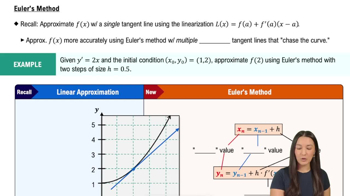2. What change of variables is suggested by an integral containing √(x² + 36)?
Table of contents
- 0. Functions7h 54m
- Introduction to Functions16m
- Piecewise Functions10m
- Properties of Functions9m
- Common Functions1h 8m
- Transformations5m
- Combining Functions27m
- Exponent rules32m
- Exponential Functions28m
- Logarithmic Functions24m
- Properties of Logarithms36m
- Exponential & Logarithmic Equations35m
- Introduction to Trigonometric Functions38m
- Graphs of Trigonometric Functions44m
- Trigonometric Identities47m
- Inverse Trigonometric Functions48m
- 1. Limits and Continuity2h 2m
- 2. Intro to Derivatives1h 33m
- 3. Techniques of Differentiation3h 18m
- 4. Applications of Derivatives2h 38m
- 5. Graphical Applications of Derivatives6h 2m
- 6. Derivatives of Inverse, Exponential, & Logarithmic Functions2h 37m
- 7. Antiderivatives & Indefinite Integrals1h 26m
- 8. Definite Integrals4h 44m
- 9. Graphical Applications of Integrals2h 27m
- 10. Physics Applications of Integrals 3h 16m
- 11. Integrals of Inverse, Exponential, & Logarithmic Functions2h 34m
- 12. Techniques of Integration7h 41m
- 13. Intro to Differential Equations2h 55m
- 14. Sequences & Series5h 36m
- 15. Power Series2h 19m
- 16. Parametric Equations & Polar Coordinates7h 58m
8. Definite Integrals
Substitution
Problem 5.R.46
Textbook Question
Evaluating integrals Evaluate the following integrals.
∫π/₁₂^π/⁹ (csc 3𝓍 cot 3𝓍 + sec 3𝓍 tan 3𝓍) d𝓍
 Verified step by step guidance
Verified step by step guidance1
Step 1: Recognize the integral components. The given integral is ∫π/₁₂^π/⁹ (csc(3𝓍)cot(3𝓍) + sec(3𝓍)tan(3𝓍)) d𝓍. Notice that the terms csc(3𝓍)cot(3𝓍) and sec(3𝓍)tan(3𝓍) are derivatives of specific trigonometric functions.
Step 2: Simplify each term using trigonometric identities. Recall that the derivative of -csc(3𝓍) is csc(3𝓍)cot(3𝓍), and the derivative of sec(3𝓍) is sec(3𝓍)tan(3𝓍). This allows us to rewrite the integral as ∫π/₁₂^π/⁹ (-d(csc(3𝓍)) + d(sec(3𝓍))).
Step 3: Apply the property of definite integrals. Since the integral is now expressed in terms of derivatives, it simplifies to evaluating the antiderivatives at the bounds. Specifically, evaluate -csc(3𝓍) and sec(3𝓍) at the limits π/₁₂ and π/⁹.
Step 4: Substitute the limits into the antiderivatives. Compute -csc(3𝓍) and sec(3𝓍) at 𝓍 = π/₁₂ and 𝓍 = π/⁹. Use the fundamental theorem of calculus to find the difference between the values at the upper and lower limits.
Step 5: Combine the results. Add the evaluated values of -csc(3𝓍) and sec(3𝓍) at the respective limits to obtain the final result of the integral.
 Verified video answer for a similar problem:
Verified video answer for a similar problem:This video solution was recommended by our tutors as helpful for the problem above
Video duration:
5mPlay a video:
Was this helpful?
Key Concepts
Here are the essential concepts you must grasp in order to answer the question correctly.
Integration
Integration is a fundamental concept in calculus that involves finding the accumulated area under a curve represented by a function. It is the reverse process of differentiation and can be used to calculate definite integrals, which provide a numerical value over a specified interval, or indefinite integrals, which yield a family of functions. Understanding the properties and techniques of integration is essential for evaluating integrals effectively.
Recommended video:

Integration by Parts for Definite Integrals
Trigonometric Functions
Trigonometric functions, such as sine, cosine, secant, cosecant, tangent, and cotangent, are crucial in calculus, especially when dealing with integrals involving angles. These functions have specific identities and relationships that can simplify the integration process. Recognizing how to manipulate these functions and apply their identities is key to solving integrals that involve trigonometric expressions.
Recommended video:

Introduction to Trigonometric Functions
Substitution Method
The substitution method is a technique used in integration to simplify the process by changing the variable of integration. This method involves substituting a part of the integrand with a new variable, which can make the integral easier to evaluate. Mastery of substitution is important for tackling complex integrals, especially those involving composite functions or trigonometric identities.
Recommended video:

Euler's Method

 8:38m
8:38mWatch next
Master Indefinite Integrals with a bite sized video explanation from Patrick
Start learningRelated Videos
Related Practice
Textbook Question
11
views
